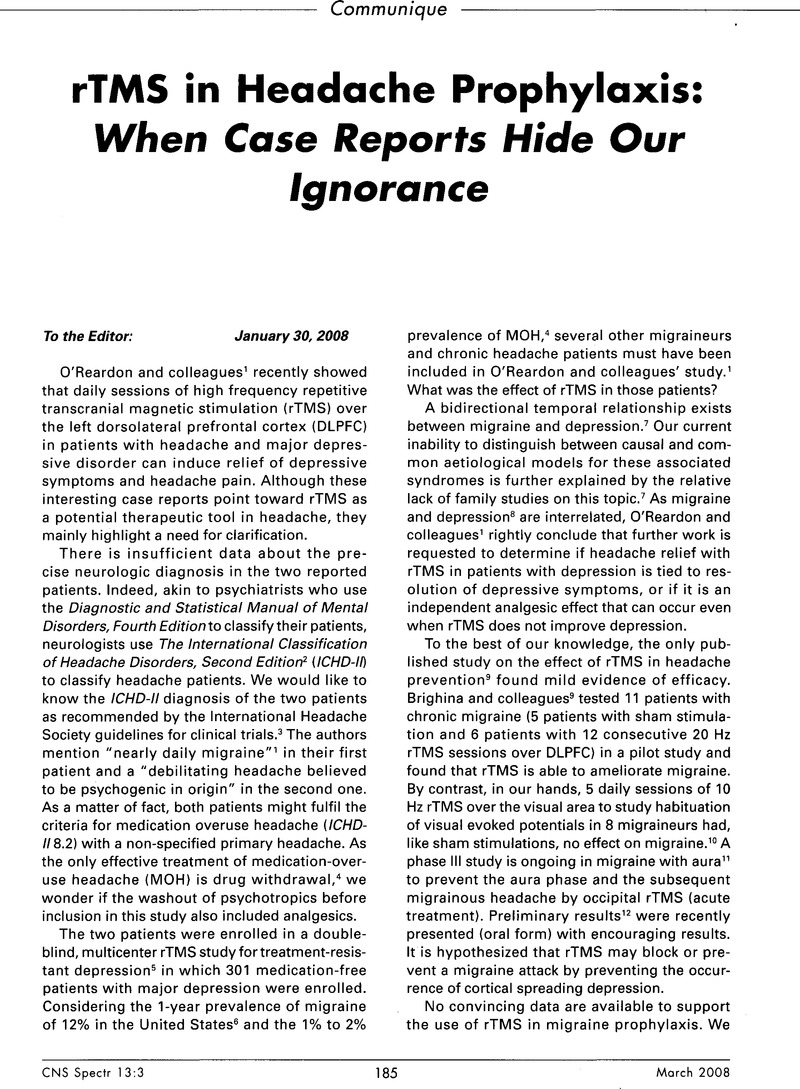No CrossRef data available.
Article contents
rTMS in Headache Prophylaxis: When Case Reports Hide Our Ignorance
Published online by Cambridge University Press: 07 November 2014
Abstract
An abstract is not available for this content so a preview has been provided. Please use the Get access link above for information on how to access this content.

- Type
- Communique
- Information
- Copyright
- Copyright © Cambridge University Press 2008
References
REFERENCES
1.O'Reardon, JRFontecha, JF, Cristancho, MA, Newman, S. Unexpected reduction in migraine and psychogenic headaches following rTMS treatment for major depression: A report of two cases. CNS Spectr. 2007;12:921–925.Google Scholar
2.The International Classification of Headache Disorders. 2nd ed (ICHD-II). Cephalalgia. 2004;24(suppl 1):1–160.Google Scholar
3.Tfelt-Hansen, P, Block, G. Dahlöf, C, et al.International Headache Society Clinical Trials Subcommittee. Guidelines for controlled trials of drugs in migraine: second edition. Cephalalgia. 2000;20:765–786.Google Scholar
4.Obermann, M. Katsarava, Z. Management of medication-overuse headache. Expert Rev Neurotherapeutics. 2007;7:1145–1155.Google Scholar
5.O'Reardon, JP, Solvason, HB, Janicak, PG, et al.Efficacy and safety of transcranial magnetic stimulation in the acute treatment of major depression: a multisite randomized controlled trial. Biol Psychiatry. 2007;62:1208–1216.Google Scholar
6.Lipton, RB, Bigal, ME, Diamond, M, et al.AMPP Advisory Group. Migraine prevalence, disease burden, and the need for preventive therapy. Neurology. 2007;68:343–349.Google Scholar
7.Radat, F, Swendsen, J. Psychiatric comorbidity in migraine: a review. Cephalalgia. 2005:25:165–178.CrossRefGoogle ScholarPubMed
8.Mitsikostas, DD, Thomas, AM. Comorbidity of headache and depressive disorders. Cephalalgia. 1999;19:211–217.Google Scholar
9.Brighina, F, Piazza, A, Vitello, G, et al.rTMS of the prefrontal cortex in the treatment of chronic migraine: a pilot study. J Neurol Sci. 2004;227:67–71.Google Scholar
10.Fumal, A, Coppola, G, Bohotin, V, et al.Induction of long-lasting changes of visual cortex excitability by five daily sessions of repetitive transcranial magnetic stimulation (rTMS) in healthy volunteers and migraine patients. Cephalalgia. 2006;26:143–149.Google Scholar
11. ClinicalTrials.gov Identifier NCT00449540. Phase III Randomized, Double-Blind, Parallel Group, Sham-Controlled Study Evaluating the Efficacy and Safety of Non-Invasive, Non-Repetitive TMS for the Acute Preemptive Treatment of the Aura Phase of Migraine Headache. http://clinicaltrials.gov/ct2/show/NCT004495407sponss%22 Neuralieve%22&spons_ex=Y&rank=1. Accessed February 5, 2008.Google Scholar
12.Mohammad, YM, Kothari, R, Hughes, G, et al.Transcranial magnetic stimulation (TMS) relieves migraine headache. Platform presentation at the American Headache Society annual scientific meeting in Los Angeles, 06 23, 2006.Google Scholar
13.Belmaker, B, Fitzgerald, P, George, MS, et al.Managing the risks of repetitive transcranial stimulation. CNS Spectr. 2003;8:489.Google Scholar
14.Schoenen, J, Bolla, M. Migraine and epilepsy. Two of a kind? K-Opinions. 2007;3:2–5.Google Scholar
1.O'Reardon, JP, Fontecha, JRCristancho, MA, Newman, S. Unexpected reduction in migraine and psychogenic headaches following rTMS treatment for major depression: a report of two cases. CNS Spectr. 2007;12:921–925.CrossRefGoogle ScholarPubMed


